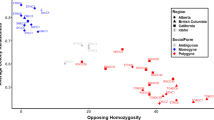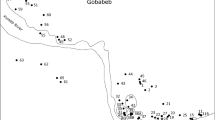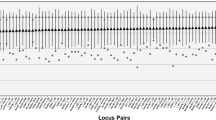Abstract
The gene Gp-9 is believed to have a major effect on colony social organization in fire ants, with the presence of b-like alleles in a colony associated with multiple-queen (polygyne) organization. Queens and workers of polygyne Solenopsis invicta homozygous for the b-like allele designated b suffer reduced viability compared to other genotypes, and bb queens do not survive to become egg-layers. Thus, the b allele effectively acts as a recessive lethal. This allele differs from the remaining b-like alleles (designated b′), as well as all other Gp-9 alleles, by encoding a lysine at position 151 in the protein product, suggesting that this substitution is responsible for its deleterious effects. We tested this hypothesis by comparing frequencies of b′b′ and bb homozygotes, first in queens of Solenopsis richteri and S. invicta, then in S. invicta workers from populations polymorphic for the two b-like alleles. We found that almost 20% of S. richteri queens were b′b′ homozygotes, compared to the virtual absence of bb homozygotes among S. invicta queens, and that 5–18% of S. invicta workers bore genotype b′b′, compared to the apparent lack of bb workers in the same populations. While we cannot entirely rule out involvement of other genes in complete gametic disequilibrium with Gp-9, our data are consistent with the hypothesis that the Lys151 residue in GP-9 protein confers the deleterious effects of the b allele in homozygous condition, possibly by impairing the protein’s function through interference with ligand binding/release or hindrance of dimer formation.
Similar content being viewed by others
References
Anholt RRH (2004) Genetic modules and networks for behavior: lessons from Drosophila. BioEssays 26:1299–1306
Baker BS, Taylor BJ, Hall JC (2001) Are complex behaviors specified by dedicated regulatory genes? Reasoning from Drosophila. Cell 105:13–24
Colosimo PF, Hosemann KE, Balabhadra S, Villarreal G, Dickson M, Grimwood J, Schmutz J, Myers RM, Schluter D, Kingsley DM (2005) Widespread parallel evolution in sticklebacks by repeated fixation of ectodyplasin alleles. Science 307:1928–1933
DeHeer CJ, Goodisman MAD, Ross KG (1999) Queen dispersal strategies in the multiple-queen form of the fire ant Solenopsis invicta. Am Nat 153:660–675
Fritz GN, Vander Meer RK, Preston CA (2006) Selective male mortality in the red imported fire ant, Solenopsis invicta. Genetics 173:207–213
Glazier AM, Nadeau JH, Aitman TJ (2002) Finding genes that underlie complex traits. Science 298:2345–2349
Goodisman MAD, Ross KG (1999) Queen recruitment in a multiple-queen population of the fire ant Solenopsis invicta. Behav Ecol 10:428–435
Goodisman MAD, Mack PD, Pearse DE, Ross KG (1999) Effects of a single gene on worker and male body mass in the fire ant Solenopsis invicta (Hymenoptera: Formicidae). Ann Entomol Soc Am 92:563–570
Goodisman MAD, Ross KG, Asmussen MA (2000) A formal assessment of gene flow and selection in the fire ant Solenopsis invicta. Evolution 54:606–616
Greenberg AJ, Wu C-I (2006) Molecular genetics of natural populations. Mol Biol Evol 23:883–886
Greenberg L, Fletcher DJC, Vinson SB (1985) Differences in worker size and mound distribution in monogynous and polygynous colonies of the fire ant Solenopsis invicta Buren. J Kans Entomol Soc 58:9–18
Hammock EAD, Young LJ (2004) Functional microsatellite polymorphism associated with divergent social structure in vole species. Mol Biol Evol 21:1057–1063
Hedrick PW (1999) Antagonistic pleiotropy and genetic polymorphism: a perspective. Heredity 82:126–133
Horst R, Damberger F, Luginbuhl P, Guntert P, Peng G, Nikonova L, Leal WS, Wuthrich K (2001) NMR structure reveals intramolecular regulation mechanism for pheromone binding and release. Proc Natl Acad Sci USA 9:14374–14379
Keller L, Ross KG (1993) Phenotypic basis of reproductive success in a social insect: genetic and social determinants. Science 260:1107–1110
Keller L, Ross KG (1998) Selfish genes: a green beard in the red fire ant. Nature 394:573–575
Keller L, Ross KG (1999) Major gene effects on phenotype and fitness: the relative roles of Pgm-3 and Gp-9 in introduced populations of the fire ant Solenopsis invicta. J Evol Biol 12:672–680
Krieger MJB (2005) To b or not to b: a pheromone-binding protein regulates colony social organization in fire ants. BioEssays 27:91–99
Krieger MJB, Ross KG (2002) Identification of a major gene regulating complex social behavior. Science 295:328–332
Krieger MJB, Ross KG (2005) Molecular evolutionary analyses of the odorant-binding protein gene Gp-9 in fire ants and other Solenopsis species. Mol Biol Evol 22:2090–2103
Kruse SW, Zhao R, Smith DP, Jones DNM (2003) Structure of a specific alcohol-binding site defined by the odorant binding protein LUSH from Drosophila melanogaster. Nat Struct Biol 10:694–700
Lartigue A, Gruez A, Spinelli S, Rivere S, Brossut R, Tegoni M, Cambillau C (2003) The crystal structure of a cockroach pheromone-binding protein suggests a new ligand binding and release mechanism. J Biol Chem 278:30213–30218
Lartigue A, Gruez A, Briand L, Blon F, Bezirard V, Walsh M, Pernollet JC, Tegoni M, Cambillau C (2004) Sulfur single-wavelength anomalous diffraction crystal structure of a pheromone-binding protein from the honeybee Apis mellifera L. J Biol Chem 279:4459–4464
Leal WS (2003) Proteins that make sense. In: Blomquist GJ, Vogt RG (eds) Insect pheromone biochemistry and molecular biology: the biosynthesis and detection of pheromones and plant volatiles. Elsevier Academic, London, pp 447–476
Lee D, Damberger FF, Peng GH, Horst R, Guntert P, Nikonova L, Leal WS, Wuthrich K (2002) NMR structure of the unliganded Bombyx mori pheromone-binding protein at physiological pH. FEBS Lett 531:314–318
Markin GP, Dillier JH, Hill SO, Blum MS, Hermann HR (1971) Nuptial flight and flight ranges of the imported fire ant, Solenopsis saevissima richteri (Hymenoptera: Formicidae) . J Ga Entomol Soc 6:145–156
Mescher MC (2001) Levels of selection and the evolution of social organization. Dissertation, University of Georgia
Mescher MC, Ross KG, Shoemaker DD, Keller L, Krieger MJB (2003) Distribution of the two social forms of the fire ant Solenopsis invicta (Hymenoptera: Formicidae) in the native South American range. Ann Entomol Soc Am 96:810–817
Nachman MW (2005) The genetic basis of adaptation: lessons from concealing coloration in pocket mice. Genetica 123:125–136
Orr HA (1998) The population genetics of adaptation: the distribution of factors fixed during adaptive evolution. Evolution 52:935–949
Orr HA (2005) The genetic theory of adaptation: a brief history. Nat Rev Genet 6:119–127
Orr HA, Coyne JA (1992) The genetics of adaptation revisited. Am Nat 140:725–742
Porter SD, Tschinkel WR (1985) Fire ant polymorphism: the ergonomics of brood production. Behav Ecol Sociobiol 16:323–336
Ross KG (1997) Multilocus evolution in fire ants: effects of selection, gene flow, and recombination. Genetics 145:961–974
Ross KG, Keller L (1995a) Ecology and evolution of social organization: insights from fire ants and other highly eusocial insects. Annu Rev Ecol Syst 26:631–656
Ross KG, Keller L (1995b) Joint influence of gene flow and selection on a reproductively important genetic polymorphism in the fire ant Solenopsis invicta. Am Nat 146:325–348
Ross KG, Keller L (1998) Genetic control of social organization in an ant. Proc Natl Acad Sci USA 95:14232–14237
Ross KG, Vargo EL, Keller L (1996) Social evolution in a new environment: the case of introduced fire ants. Proc Natl Acad Sci USA 93:3021–3025
Ross KG, Krieger MJB, Shoemaker DD, Vargo EL, Keller L (1997) Hierarchical analysis of genetic structure in native fire ant populations: results from three classes of molecular markers. Genetics 147:643–655
Ross KG, Shoemaker DD, Krieger MJB, DeHeer CJ, Keller L (1999) Assessing genetic structure with multiple classes of molecular markers: a case study involving the introduced fire ant Solenopsis invicta. Mol Biol Evol 16:525–543
Ross KG, Krieger MJB, Shoemaker DD (2003) Alternative genetic foundations for a key social polymorphism in fire ants. Genetics 165:1853–1867
Sandler BH, Nikonova L, Leal WS, Clardy J (2000) Sexual attraction in the silkworm moth: structure of the pheromone-binding protein-bombykol complex. Chem Biol 7:143–151
Shoemaker DD, Ross KG (1996) Effects of social organization on gene flow in the fire ant Solenopsis invicta. Nature 383:613–616
Shoemaker DD, DeHeer CJ, Krieger MJB, Ross KG (2006) Population genetics of the invasive fire ant Solenopsis invicta (Hymenoptera: Formicidae) in the United States. Ann Entomol Soc Am (in press)
Storz JF (2005) Using genome scans of DNA polymorphism to infer adaptive population divergence. Mol Ecol 14:671–688
Tschinkel WR, Mikheyev AS, Storz SR (2003) Allometry of workers of the fire ant, Solenopsis invicta. J Insect Sci 3:1–11
Vasemägi A, Primmer CR (2005) Challenges for identifying functionally important genetic variation: the promise of combining complementary research strategies. Mol Ecol 14:3623–3642
Vogt RG (2003) Biochemical diversity of odor detection: OBPs, ODEs and SNMPs. In: Blomquist GJ, Vogt RG (eds) Insect pheromone biochemistry and molecular biology: the biosynthesis and detection of pheromones and plant volatiles. Elsevier Academic, London, pp 391–445
Vogt RG (2005) Molecular basis of pheromone detection in insects. In: Gilbert LI, Iatro K, Gill S (eds) Comprehensive insect physiology, biochemistry, pharmacology and molecular biology, vol 3. Endocrinology. Elsevier Academic, London, pp 753–803
Wright SI, Gaut BS (2005) Molecular population genetics and the search for adaptive evolution in plants. Mol Biol Evol 22:506–519
Xu PX, Atkinson R, Jones DNM, Smith DP (2005) Drosophila OBP LUSH is required for activity of pheromone-sensitive neurons. Neuron 45:193–200
Acknowledgments
We thank Dietrich Gotzek, Robert Matthews, and Daniel Promislow for comments on an earlier draft of this manuscript.
Author information
Authors and Affiliations
Corresponding author
Rights and permissions
About this article
Cite this article
Hallar, B.L., Krieger, M.J.B. & Ross, K.G. Potential cause of lethality of an allele implicated in social evolution in fire ants. Genetica 131, 69–79 (2007). https://doi.org/10.1007/s10709-006-9114-5
Received:
Accepted:
Published:
Issue Date:
DOI: https://doi.org/10.1007/s10709-006-9114-5




